By Dr. Maddie Swannack and Dr. Sachin Sudhakaran
Next Lesson - The Nose
Abstract
- Conditions of the outer ear include pathologies of the pinna and the external auditory meatus. These include foreign bodies and impacted wax that are blocking the meatus.
- Pinna haematomas occur as a result of trauma and can progress to cauliflower deformities if untreated.
- Otitis externa is inflammation of the outer ear commonly due to infection.
- Ramsey-Hunt Syndrome is caused by the Varicella Zoster Virus and is ‘shingles of the facial nerve’, causing a vesicular rash in the ear.
- Otitis media is an umbrella term for inflammation in the middle ear cavity.
- Acute otitis media is an infection of the middle ear cavity common in children due to the angle of their Eustachian tube. It can progress to perforation of the tympanic membrane.
- Otitis media with effusion (aka glue ear) can also occur due to Eustachian tube dysfunction and is a collection of fluid in the middle ear without active infection.
- Mastoiditis is the spreading of a middle ear infection into the mastoid bone.
- A cholesteatoma is a proliferation of trapped epithelial cells which can erode through bone if untreated.
- Otosclerosis is a fairly common cause of hearing loss in young adults and occurs when irregular bone is laid around the ossicles, preventing them from vibrating.
- BPPV is caused by crystals forming in the semi-circular canals of the inner ear which continue to move after the head becomes stationary, causing vertigo that settles. It causes no hearing abnormalities, is diagnosed using the Dix-Hallpike test and is treated using the Epley Manoeuvre.
- Meniere’s disease is caused by an increased amount of fluid in the inner ear, presenting with fluctuating hearing loss, vertigo, and tinnitus.
- Labyrinthitis and vestibular neuronitis are both conditions of inflammation of part of the vestibulocochlear nerve caused by viral infection, presenting with acute vertigo and possible hearing loss or tinnitus.
- An acoustic neuroma is a benign tumour of the vestibulocochlear nerve causing unilateral hearing loss.
- Presbycusis is age related hearing loss.
Core
This article follows on from our Anatomy of the Ear article.
Conditions of the External Ear
Foreign bodies within the ear canal are a common ear-related complaint in children. Diagnosis can be delayed by children being unwilling to volunteer a history and should be considered as a differential diagnosis. It is important that any foreign bodies in the ears are removed but should be done carefully to avoid pushing the object further in or causing more damage.
Wax in the ears is normal. It only becomes pathological if the wax has become so impacted that it is affecting hearing. It can be softened with self-administered olive oil drops helping the wax to fall out naturally.
A pinna haematoma is the accumulation of blood between the cartilage of the pinna and its overlying perichondrium. This is usually secondary to blunt trauma.
If left untreated the haematoma can cause increased pressure depriving the cartilage of its blood supply, eventually leading to necrosis. Prompt drainage and splinting is required to prevent fibrosis and asymmetrical cartilage development which will lead to a ‘cauliflower deformity’.
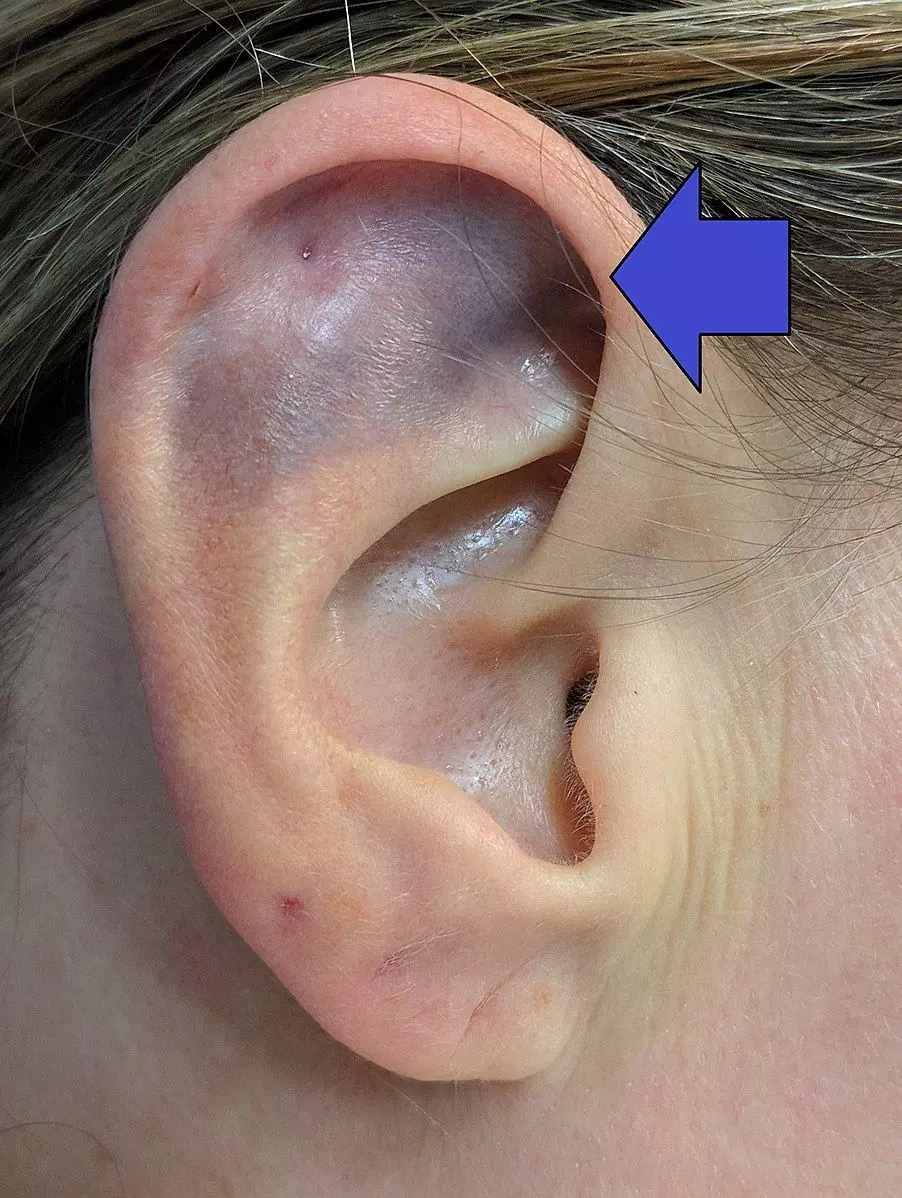
Image - Haematoma of the pinna
Creative commons source by James Heilman, MD [CC BY-SA 4.0 (https://creativecommons.org/licenses/by-sa/4.0)]

Image - Cauliflower deformity caused by an untreated pinna haematoma
Creative commons source by MartialArtsNomad.com [CC BY-SA 4.0 (https://creativecommons.org/licenses/by-sa/4.0)]
Otitis externa is inflammation of the structure of the outer ear, which is typically the result of infection, with ~90% being bacterial in origin (commonly Pseudomonas aeruginosa or Staphylococcus aureus) and the remaining ~10% being fungal in origin.
Risk factors include foreign bodies, swimming and placing cotton wool buds in the ear.
Patients may present with a painful ear canal with visible erythema, oedema and serous exudate. It may present with a conductive hearing loss in severe cases due to stenosis of the ear canal.
The condition is generally self-limiting, so appropriate self-care advice and safety netting are usually sufficient. Self-care with paracetamol analgesia and avoiding precipitating factors. Topical acetic acid spray can be purchased over the counter to help ease symptoms.
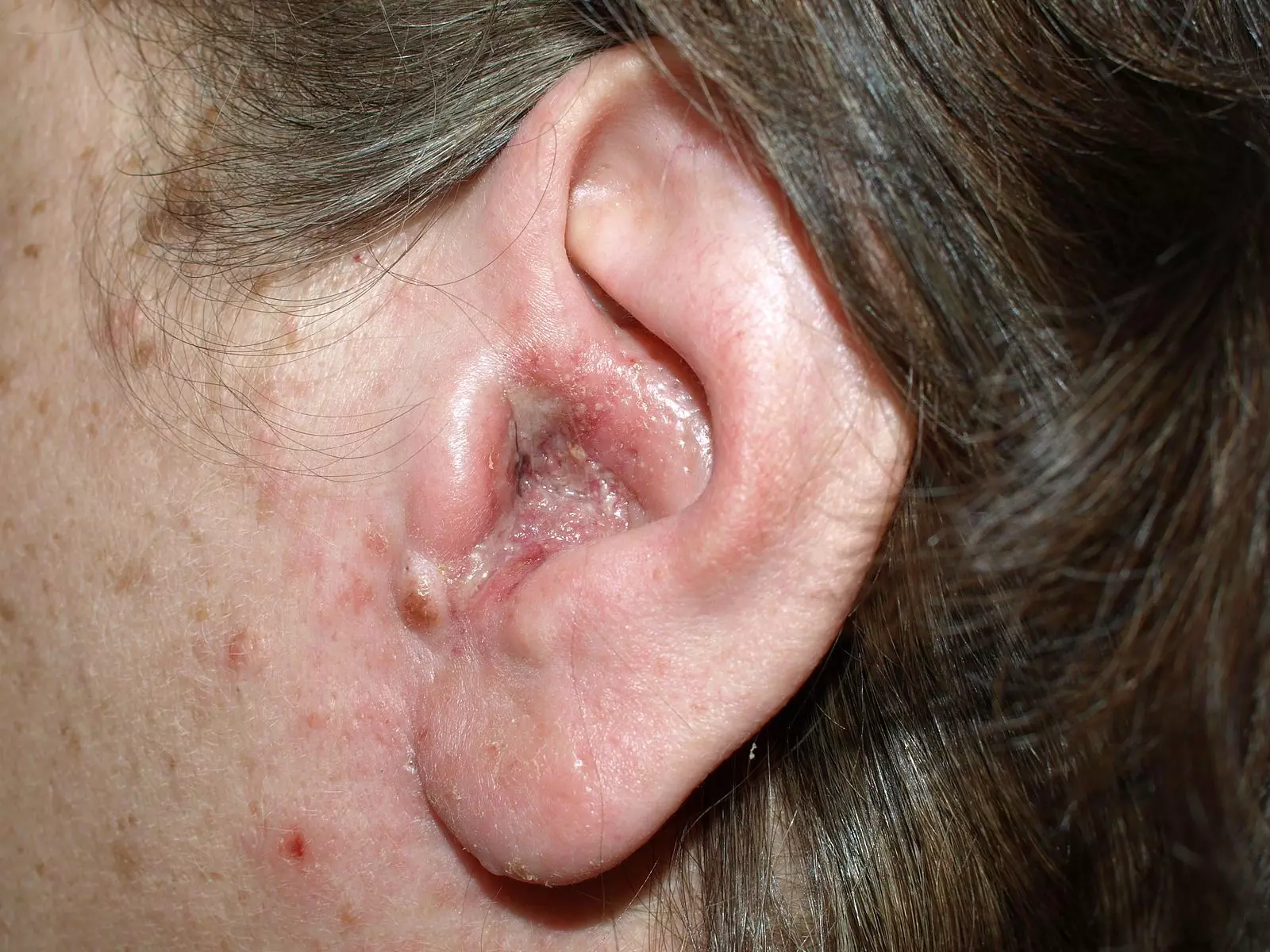
Image - Otitis externa
Creative commons source by Klaus D. Peter, Wiehl, Germany [CC BY-SA 4.0 (https://creativecommons.org/licenses/by-sa/4.0)]
Ramsey-Hunt Syndrome (also known as Herpes Zoster Oticus) is a disorder caused by the reactivation of the Varicella Zoster virus in the facial nerve. It is therefore ‘Shingles of the Facial nerve’.
Ramsey-Hunt Syndrome typically presents with unilateral paralysis of the muscles of facial expression, loss of hearing in one ear, change in taste, dry eyes and mouth, and a painful vesicular rash in one ear.
Treatment is more effective if started early and includes antiviral and steroid medication.
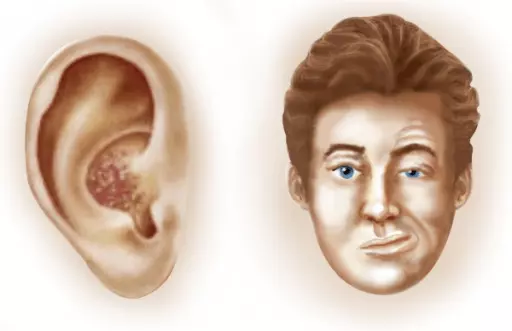
Image - Typical facial nerve palsy and rash seen in Ramsey-Hunt Syndrome
Creative commons source by Worme M, Chada R, Lavallee L [CC BY-SA 4.0 (https://creativecommons.org/licenses/by-sa/4.0)]
Acute otitis media (AOM) is an infection of the middle ear. As discussed in our article on the anatomy of the ear (article here), it is a common condition in children due to the flatter Eustachian tube (as already mentioned). Enlarged adenoidal tissue in the throat can predispose to infection as a result.
Common causative organisms include bacteria such as Haemophilus influenzae and Streptococcus pneumoniae, and viruses such as respiratory syncytial virus and rhinovirus.
Patients usually complain of otalgia (pain in the ear), which may present in children with a tugging on the ear, fever and malaise. On otoscopy, the tympanic membrane (TM) may appear to be bulging, erythematous and may have air bubbles or a visible fluid level behind it. There may also be discharge from the ear if the ear drum perforates from the pressure inside the middle ear.
Treatment of acute otitis media is mainly symptomatic with analgesics and antipyretics (for example paracetamol).
The use of antibiotics in treating ear infections is a developing area. Broadly speaking, however, individuals with severe systemic infection or acute intracranial complications, e.g. meningitis or mastoiditis, should be admitted to hospital. Otherwise antibiotics should only be given in cases with otorrhoea or those under 2 years of age with bilateral infection (Source). (NB always ensure to check your local guidelines)
In especially severe cases of AOM there are potentially serious complications most of which are rare, including:
- Perforation of the tympanic membrane +/- hearing loss
- Recurrence of infection
- Facial nerve palsy
- Mastoiditis
- Meningitis
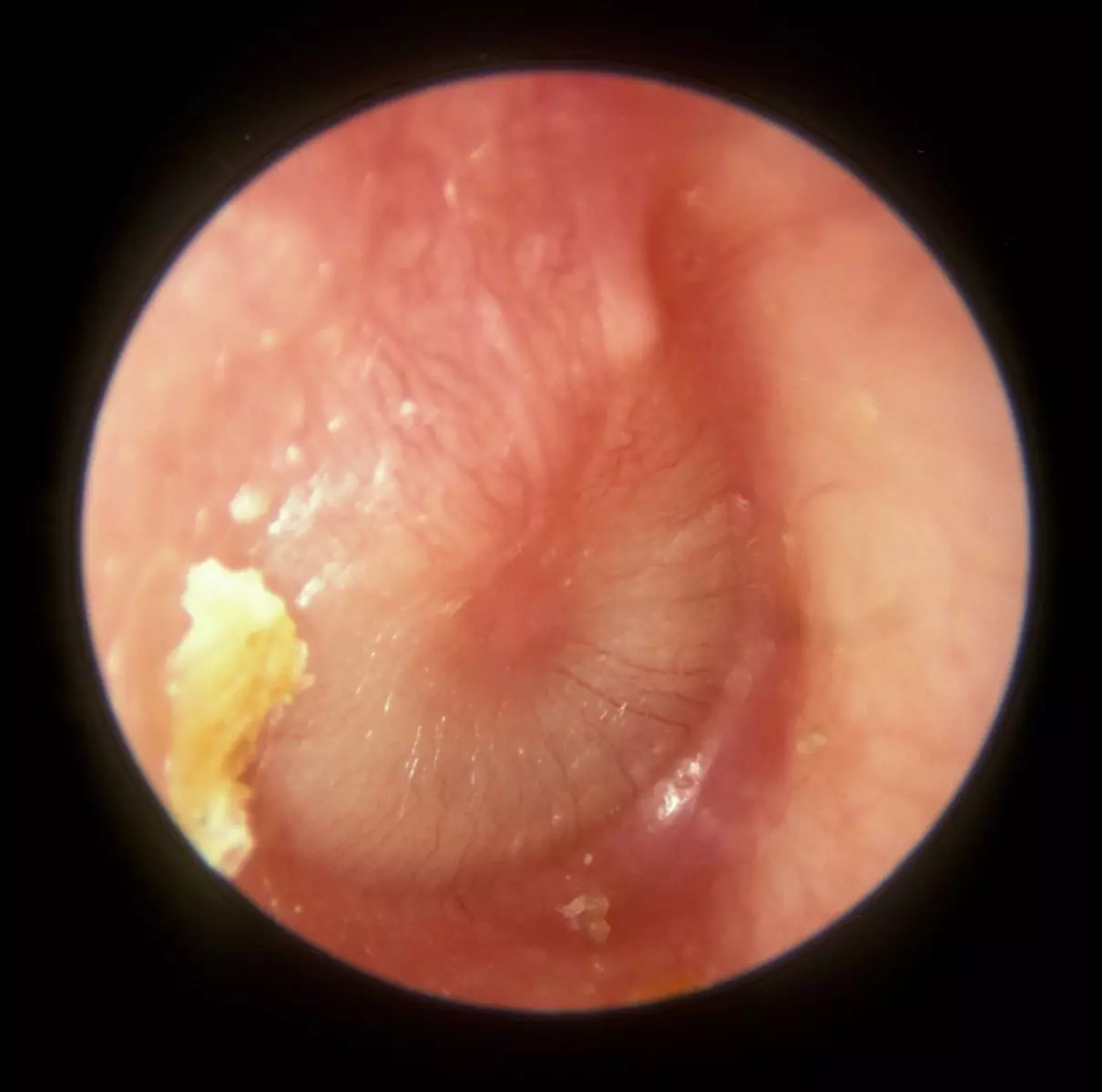
Image - Otitis media. Note the erythematous tympanic membrane, which is bulging outward, shown by the loss of the cone of light. There is no fluid level visible, but that does not rule out infection. The yellow on the left is ear wax and is not pathological in this case
Creative commons source by Michael Hawke MD [CC BY-SA 4.0 (https://creativecommons.org/licenses/by-sa/4.0)]
Perforation of the Tympanic Membrane
If the TM is damaged there is a risk that it may perforate. This can lead to otalgia and discharge from the ear, with possible sudden conductive hearing loss. Most cases of perforation should heal within a few weeks, however, it is still recommended that suspected perforations be examined. Careful inspection is required to identify the location and extent of the perforation and if there are any signs of infection. In rare cases attic perforations (at the top) can lead to cholesteatoma.
If the hole does not heal there may be long lasting effect to hearing and can predispose toward chronic suppurative otitis media, a chronic inflammation of the middle ear with recurrent discharge. This condition should be managed by an ENT specialist.
Perforations can be repaired surgically, but this can only occur once there is no infection present and is only indicated when hearing is impaired.
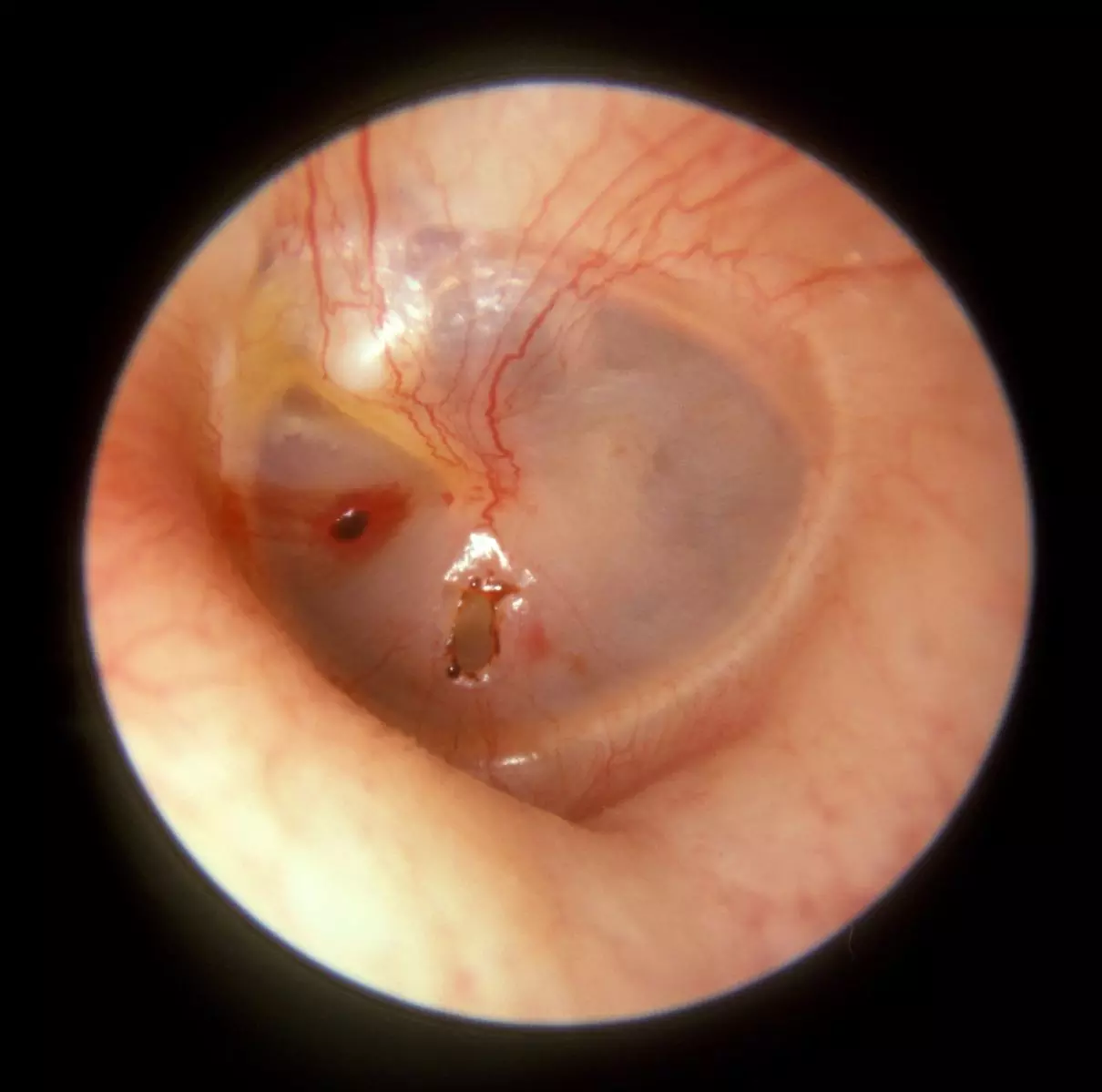
Image - Perforated tympanic membrane, the perforation is visible just under the umbo
Creative commons source by Michael Hawke MD [CC BY-SA 4.0 (https://creativecommons.org/licenses/by-sa/4.0)]
Otitis media with effusion (OME), also known as glue ear, is a condition characterised by a collection of fluid in the middle ear without active infection.
The precise cause of the condition is unclear but is thought to occurs when the Eustachian tube becomes blocked usually after an episode of AOM. As discussed in the anatomy of the ear article (article here) the mucosa of the middle ear is constantly absorbing air. Usually this is not an issue as the Eustachian tube allows air to enter the middle ear from the nasopharynx. However, in OME the eustachian tube becomes blocked and as a result the air in the middle ear cannot be replaced leading to a negative pressure within the middle ear. As a result, fluid is drawn into the middle ear and collects causing symptoms.
The condition is much more common in children due to the anatomy of the Eustachian tube. It is important that it is treated promptly as it can impair hearing, which can cause delay in the development of language skills in children. Signs in children can include these delays, or signs like having to have the TV on very loud.
On examination, the tympanic membrane is likely to be concave or retracted (due to negative pressure), with bubbles visible (collected fluid) behind the surface and is often accompanied by a feeling of ‘fullness’ in the ear.
Risk factors for otitis media with effusion include increased colonisation of the adenoids or nasopharynx (for example at day care), parents who smoke, and Eustachian tube dysfunction.
Management of otitis media with effusion is generally not needed as most cases resolve spontaneously. Hearing aids can be useful in the acute phase, and if recurrent or causing significant developmental delay, a tympanostomy can be performed. This is the surgical cutting of the tympanic membrane to place a grommet (small plastic tube) through the tympanic membrane to help the middle ear cavity equalise the pressure and are not meant to drain fluid. Grommets stay in the ear for around 6-12 months allowing time for the condition to resolve and the Eustachian tube to develop.
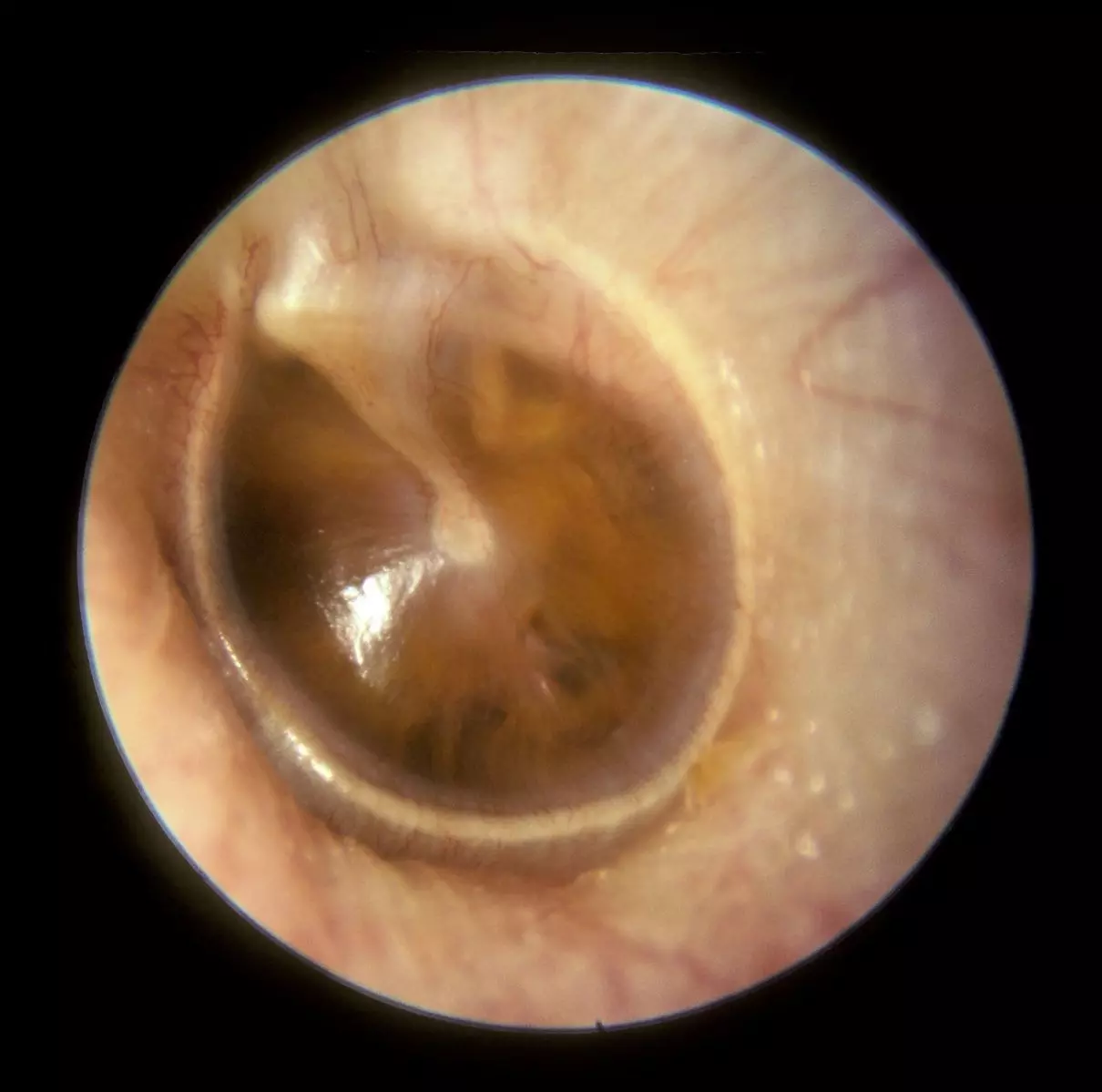
Image - Otitis media with an effusion. Notice the presence of straw coloured fluid through the tympanic membrane and the retracted appearance of the membrane
Creative commons source by Michael Hawke MD [CC BY-SA 4.0 (https://creativecommons.org/licenses/by-sa/4.0)]
Mastoiditis is a serious condition caused by the spread of infection from the middle ear cavity into the air cells of the mastoid bone. The middle ear cavity is connected to the mastoid air cells via the mastoid antrum, providing a path for the spread of infection. Spread of infection to the mastoid bone can cause brain abscesses or meningitis so needs prompt admission to hospital and treatment with IV antibiotics.
Mastoiditis presents classically with the pinna of the affected ear being pushed forward by a swelling over the mastoid process (posterior to the ear). There may also be symptoms similar to AOM along with erythema, tenderness, and pain over the mastoid process.
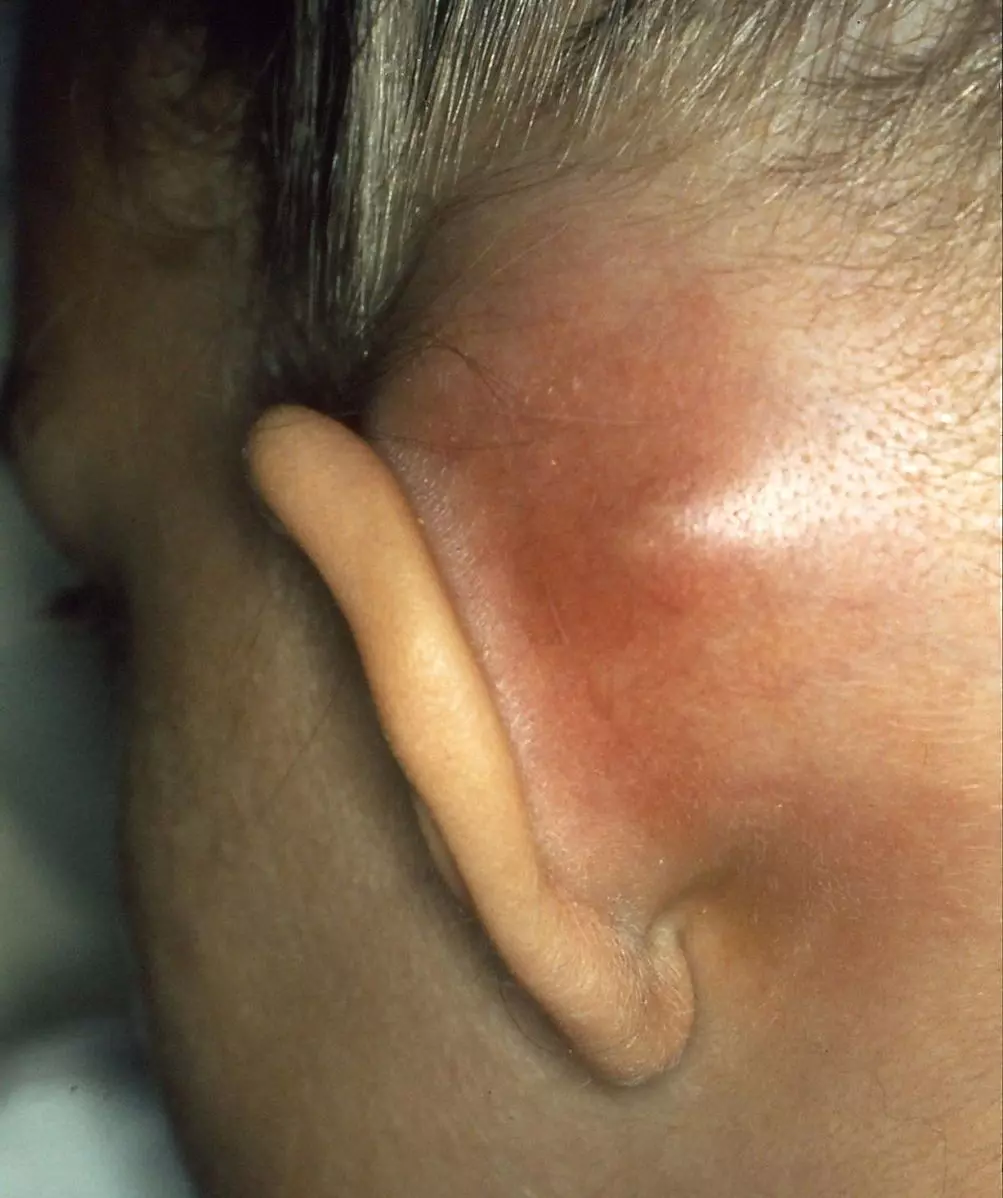
Image - Presentatino of mastoiditis with a swollen and erythematous mastoid process pushing the pinna forwards
Creative commons source by B. Welleschik [CC BY-SA 4.0 (https://creativecommons.org/licenses/by-sa/4.0)]
A cholesteatoma is a rare condition caused by a collection of trapped epithelial cells. If left untreated the trapped cells can proliferate and erode into surrounding structures, leading to bony destruction (e.g. erosion of mastoid/petrous bone and ossicles) which can lead to hearing loss and infection. Cholesteatomas usually present with a painless, watery and offensive-smelling discharge from the ear, and gradual hearing loss.
It is thought to occur when the pars flaccida is pulled into the middle ear by negative pressure (associated with Eustachian tube dysfunction, see above) trapping epithelial cells which can then proliferate.
Untreated, cholesteatomas can lead to facial nerve palsy, meningitis and cerebral abscess, so any patient with suspicion of cholesteatoma should be referred for investigation.
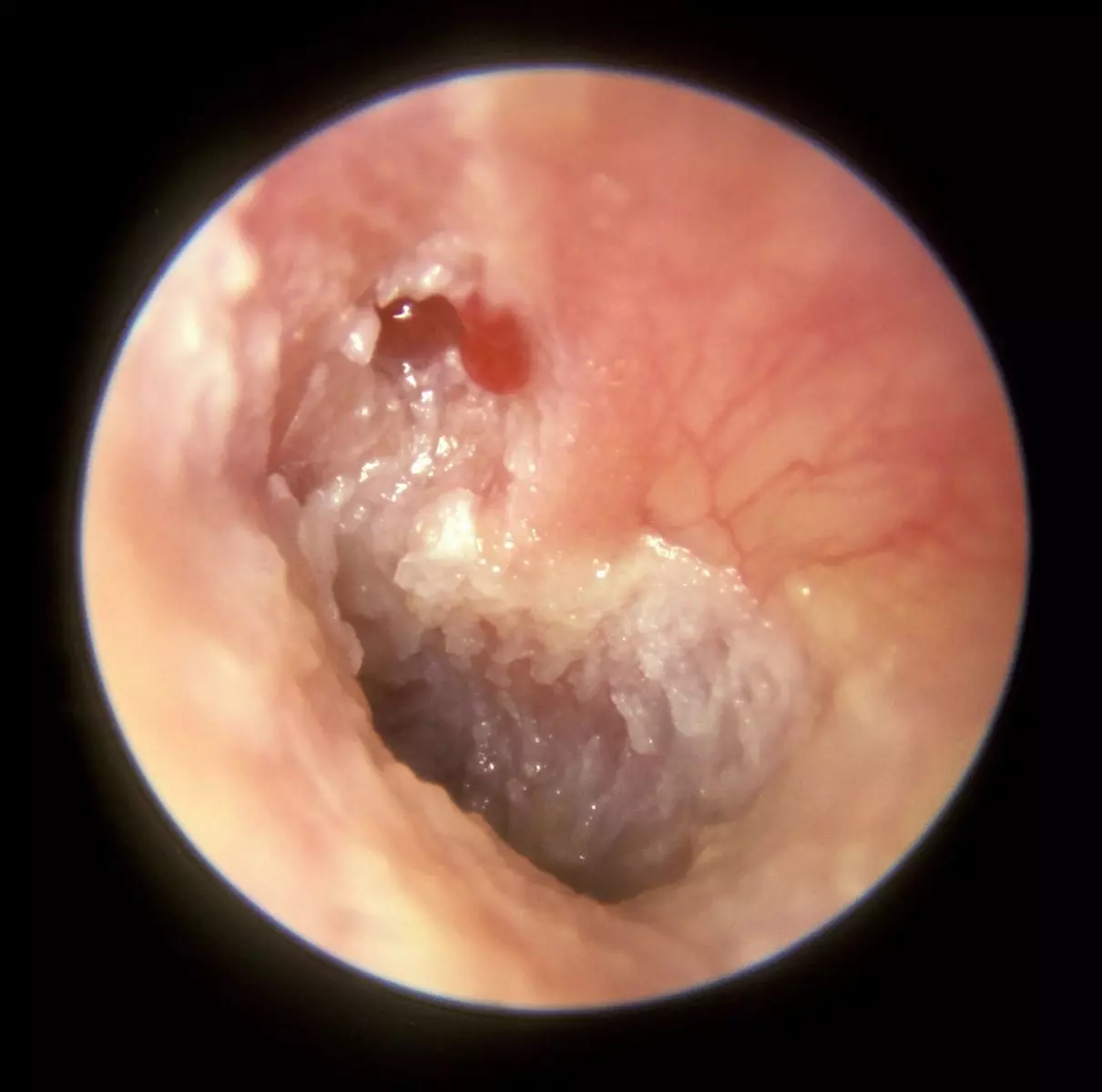
Image - Cholesteatoma following an attic perforation in the tympanic membrane
Creative commons source by Michael Hawke MD [CC BY-SA 4.0 (https://creativecommons.org/licenses/by-sa/4.0)]
Otosclerosis is a condition where bone forms around the ossicles (commonly the base of the stapes) causing fusion of the articulations of the ossicles. As a result, vibrations aren’t transmitted to the cochlea as effectively causing a conductive hearing loss, which can be associated with tinnitus or vertigo depending on the spread of the bony growth.
It is an important differential diagnosis in any young person presenting with conductive hearing loss.
When considering conditions of the inner ear, it is important to understand two key symptoms.
- Vertigo – the illusion of movement when no movement is present, for example feeling like the room is spinning, or feeling like the patient is on a ship.
- Tinnitus – the hearing of a sound that is not present, for example dripping or ringing.
Benign Paroxysmal Positional Vertigo (BPPV)
BPPV is a disorder characterised by repeated episodes of positional vertigo, meaning the symptoms occur following movement of the head.
It is caused by crystals of calcium carbonate forming in the semi-circular canals of the vestibule, causing the fluid to continue to shift after the movement of the head has stopped.
It presents with dizziness on head movement that resolves when the crystals settle (normally takes less than one minute). This can lead to nystagmus (movement of the eyes), nausea and vomiting but does not affect hearing.
It is diagnosed using the Dix-Hallpike Test. The manoeuvre is conducted by first asking the patient to sit on the couch and asking the patient to keep their eyes open throughout the procedure. First the turn the patient’s head to one side and rapidly lay them down supine so that their head hangs over the edge of the bed so meaning their head is rotated 45 degrees to one side and 30 degrees extended. Observe the patient’s eyes for nystagmus which if present indicates BPPV.
BPPV is treated using the Epley Manoeuvre – this is a series of movements of the head to help the crystals to fall out of the semi-circular canals to prevent the ripples.
The Epley Manoeuvre begins with the Dix-Hallpike Manoeuvre, so the patient ends up laying supine with their head turned to one side and hanging off the bed. Keep the patient in this position for 1-2 minutes, then rotate the head 90 degrees to the other side, keeping the extension of the neck. Keep the patient in this position for 1-2 minutes, then, while keeping the head in the same position relative to the shoulders, rotate the patient’s whole body another 90 degrees so the patient is now looking at the floor. Keep the patient in this position for 1-2 minutes, then slowly help them to sit up.
Meniere’s Disease is a condition of excess fluid in the ducts of the inner ear. The cause is unknown, but risk factors include viral infection, head trauma and autoimmune conditions.
It presents with a fluctuating sensorineural hearing loss (which helps differentiate it from BPPV as there is no hearing loss in BPPV), as well as tinnitus and vertigo.
Diagnosis is difficult as there is no set test, but diagnosis is important because it can contribute to falls, social effects like affecting the ability to work or drive and may have psychological effects (Meniere’s disease can contribute to anxiety and depression).
Labyrinthitis and Vestibular Neuronitis
A viral infection causing inflammation of one part of cranial nerve VIII. In labyrinthitis, the cochlear portion specifically is inflamed, in vestibular neuronitis the vestibular part specifically is inflamed. Clinically, they are very similar in cause, presentation, and management.
They present with acute and persistent vertigo that is not brought on by anything and may be associated with hearing loss or tinnitus.
The condition is generally self-limiting, but anti-nausea drugs may be needed.
A benign tumour of the vestibulocochlear nerve. This is a common cause of unilateral sensioneural hearing loss.
Presbycusis is age related hearing loss and is a progressive bilateral sensorineural hearing loss.
Persistent exposure to loud noise can cause hearing loss. It can be occupational in origin is common in those working with power tools without adequate ear protection.
Edited by: Dr. Ben Appleby
Reviewed by: Dr. Thomas Burnell
- 2652

